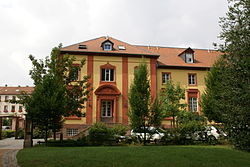Kirchheimbolanden Castle
| Kirchheimbolanden Castle | |
|---|---|
 Kirchheimbolanden Castle |
|
| Data | |
| place | Kirchheimbolanden |
| builder | Guillaume d'Hauberat |
| architect | Guillaume d'Hauberat |
| Client | Prince Karl August von Nassau-Weilburg |
| Architectural style | Late baroque |
| Construction year | 1738-1740 |
The Schloss Kirchheimbolanden is located in the town of Kirchheimbolanden in Rhineland-Palatinate . The facility was first mentioned as a castle in 1390.
history
From 1602 to 1618 a castle (the so-called "old castle") was built outside the actual city walls by the Counts of Nassau-Weilburg , who had their permanent residence in Weilburg an der Lahn .
A new building was built between 1738 and 1740 under Prince Carl-August von Nassau-Weilburg . Karl August was an imperial prince and wanted a contemporary building. Guillaume d'Hauberat was hired as the architect and builder , who also built the Mannheim Palace and the Schwetzingen Palace for the Elector of the Palatinate . A palace garden was to be laid out in the form of a terrace at the new palace , the irrigation of which should come from the copper mines in the nearby village of Haide . Some of these water channels have been preserved to this day.
After the occupation of nearby Mainz by the French, Prince Friedrich-Wilhelm von Nassau-Weilburg fled Kirchheimbolanden to Bayreuth in 1793 . This ended the palace's function as a princely residence, and with it the rule of the Princes of Nassau-Weilburg over this region.
In 1807 the palace and palace gardens were declared French national property and could therefore be sold. The plant was auctioned in Mainz in 1807, as Mainz was now the administrative seat of the Donnersberg department . The landowner and textile manufacturer Daniel Andreas from Mülheim an der Ruhr bought the property. He had the central building and the left wing of the palace removed and moved into his private apartment in the remaining right wing of the palace.
After the end of French rule, the Donnersberg department fell to the Kingdom of Bavaria in 1816 . The region was first referred to as the Rhine District , later as the Rheinpfalz .
On March 21, 1839, Kirchheimbolanden Castle was sold to the Bavarian master builder Leo von Klenze from Munich . He had extensive structural changes made, but did not take up permanent residence in the castle. In 1841 he sold the plant to the pensioner Heinrich Seligmann from Mainz, who in turn sold it in 1844 to the farmer Friedrich Brunck from nearby Winterborn / Alsenz.
In 1848/49 the Palatinate irregulars declared the castle their headquarters, but were soon driven out by Prussian troops.
On November 3, 1861, the still standing east wing of the palace burned down. Friedrich Brunck had it rebuilt in a simplified form with two floors and a hipped roof .
In 2003 the old U-shape of the castle was rebuilt as the “Seniorenresidenz Schloss Kirchheimbolanden”, whereby only the east wing is reminiscent of its former shape and its splendor. But in this way the contours of the old castle have risen again as a three-wing complex.
For the layout of the palace garden, Dr. Heinrich Ritter von Brunck commissioned the Frankfurt garden designer Heinrich Siesmayer . The latter had been commissioned by the grandson (Duke Adolf von Nassau) of the last prince who resided in Kirchheimbolanden and then fled with the sale of his extensive plant and tree collection from Schloss Biebrich near Wiesbaden , as the Prussians annexed his Duchy of Nassau in 1866.
literature
- Heinel, Jürgen: The senior citizens' residence Schloß Kirchheimbolanden and their princely origins . Otterbach 1995
- Lehna, Britta: A buyer for the Kirchheimbolander castle: Marshal Kellermann's petition to Emperor Napoleon I. In: Donnersberg-Jahrbuch . Ed. 15, 1992, pp. 68-70
- Mayer, Peter: The Palatinate . 8th edition, DuMont Reiseverlag, Cologne 1992
Web links
Coordinates: 49 ° 40 ′ 0.7 " N , 8 ° 0 ′ 43.2" E
